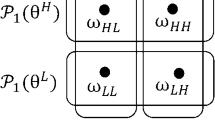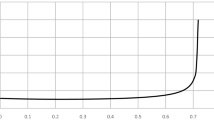Abstract
We study a model of imperfectly discriminating contests with two ex ante symmetric agents. We consider four institutional settings: Contestants move either sequentially or simultaneously and in addition their types are either public or private information. We find that an effort-maximizing designer of the contest prefers the sequential to the simultaneous setting from an ex ante perspective. Moreover, the sequential contest Pareto dominates the simultaneous one when the contestants’ types are sufficiently negatively correlated. Regarding the information structure, the designer ex ante prefers private information while the contestants prefer public information.
Similar content being viewed by others
References
Aoyagi, M. (2010). Information feedback in a dynamic tournament. Games and Economic Behavior, 70, 242–260.
Baik, K. H., & Shogren, J. F. (1992). Strategic behavior in contests: comment. American Economic Review, 82(1), 359–362.
Clark, D., & Riis, C. (1998). Contest success functions: an extension. Economic Theory, 11, 201–204.
Dixit, A. (1987). Strategic behavior in contests. American Economic Review, 77(5), 891–898.
Glazer, A., & Hassin, R. (2000). Sequential rent seeking. Public Choice, 102, 219–228.
Gradstein, M., & Konrad, K. (1999). Orchestrating rent seeking contests. Economic Journal, 109, 536–545.
Harris, C., & Vickers, J. (1985). Perfect equilibrium in a model of a race. The Review of Economic Studies, 52(2), 193–209.
Harris, C., & Vickers, J. (1987). Racing with uncertainty. The Review of Economic Studies, 54(1), 1–21.
Hurely, T., & Shogren, J. (1998a). Effort levels in a Cournot Nash contest with asymmetric information. Journal of Public Economics, 69, 195–210.
Hurely, T., & Shogren, J. (1998b). Asymmetric information contests. European Journal of Political Economy, 14, 645–665.
Jackson, M. O., Simon, L. K., Swinkels, J. M., & Zame, W. R. (2002). Communication and equilibrium in discontinuous games of incomplete information. Econometrica, 70(5), 1711–1740.
Jost, P.-J., & Kräkel, M. (2006). Simultaneous- and sequential-move tournaments with heterogeneous agents. Schmalenbach Business Review, 58, 306–331.
Konrad, K. A. (2007). Strategy in contests—an introduction. WZB-Markets and Politics Working Paper No. SP II 2007-01.
Leininger, W. (1993). More efficient rent-seeking—a Münchhausen solution. Public Choice, 75, 43–64.
Linster, B. (1993). Stackelberg rent-seeking. Public Choice, 77(2), 307–321.
Ludwig, S. (2007). Essays on the effects of information on incentives and on people’s awareness and assessment of biases. Ph.D. thesis, University of Bonn.
Ludwig, S. (2011). Contests—a comparison of timing and information structures. Discussion Papers in Economics, 12209, University of Munich.
Malueg, D., & Yates, A. (2004). Rent seeking with private values. Public Choice, 119, 161–178.
Moldovanu, B., & Sela, A. (2006). Contest architecture. Journal of Economic Theory, 126(1), 70–97.
Morgan, J. (2003). Sequential contests. Public Choice, 116, 1–18.
Münster, J. (2009). Repeated contests with asymmetric information. Journal of Public Economic Theory, 11(1), 89–118.
Nitzan, S. (1994). Modeling rent seeking contests. European Journal of Political Economy, 10, 41–60.
Pal, D. (1991). Cournot duopoly with two production periods and cost differentials. Journal of Economic Theory, 55, 441–448.
Romano, R., & Yildirim, H. (2005). On the endogeneity of Cournot–Nash and Stackelberg equilibria: games of accumulation. Journal of Economic Theory, 102, 73–107.
Rosen, S. (1986). Prizes and incentives in elimination tournaments. American Economic Review, 76(4), 701–715.
Saloner, G. (1987). Cournot duopoly with two production periods. Journal of Economic Theory, 42, 183–187.
Simon, L. K., & Zame, W. R. (1990). Discontinuous games and endogenous sharing rules. Econometrica, 58(4), 861–872.
Skaperdas, S. (1996). Contest success functions. Economic Theory, 7, 283–290.
Tullock, G. (1980). Efficient rent-seeking. In J. Buchanan et al. (Eds.), Toward a theory of the rent-seeking society (pp. 97–112). College Station: Texas A&M University Press.
Wärneryd, K. (2003). Information in conflicts. Journal of Economic Theory, 110, 121–136.
Yildirim, H. (2005). Contests with multiple rounds. Games and Economic Behavior, 51, 213–227.
Author information
Authors and Affiliations
Corresponding author
Rights and permissions
About this article
Cite this article
Ludwig, S. Contests—a comparison of timing and information structures. Public Choice 153, 341–355 (2012). https://doi.org/10.1007/s11127-011-9797-8
Received:
Accepted:
Published:
Issue Date:
DOI: https://doi.org/10.1007/s11127-011-9797-8




